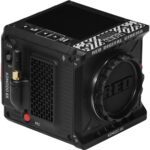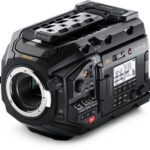Key Takeaways
-
The Canon EOS C300 Mark III is a game-changer for primate documentaries, offering a new level of image quality and flexibility.
-
Its Super 35mm Dual Gain Output (DGO) sensor ensures excellent low-light performance and high dynamic range, essential for capturing primates in their natural habitats.
-
Multiple recording formats, including 4K Cinema RAW Light, provide filmmakers with a variety of post-production options.
-
Advanced autofocus capabilities and user-friendly design make the C300 Mark III ideal for the dynamic environment of wildlife filmmaking.
-
Real-world examples demonstrate the camera’s impact on primate documentary storytelling and its potential to bring these stories to a wider audience.
Capturing the Wild: EOS C300 Mark III’s Impact on Primate Documentaries
When you’re out in the wild, documenting the untamed lives of primates, every frame matters. The right camera can mean the difference between capturing a fleeting moment in stunning clarity or missing the shot entirely. The Canon EOS C300 Mark III is not just any camera—it’s a storyteller’s dream, especially for primate documentaries where precision, reliability, and quality are non-negotiable.
Revolutionizing Primate Storytelling Through Technology
The heart of the C300 Mark III lies in its Super 35mm Dual Gain Output (DGO) sensor. This innovation is a giant leap forward, especially when filming in the variable lighting conditions of the jungle. The DGO sensor delivers high dynamic range and low noise levels by reading each pixel at two different gain levels—one prioritizes saturation in the highlights, the other suppresses noise in the shadows. The result? Primate fur detail that stands out, expressive eyes that tell a story, and an overall image that feels as alive as the jungle itself.
Moreover, the camera’s ability to shoot 4K at up to 120 frames per second allows you to slow down the fast-paced action of primates leaping from tree to tree, offering viewers an intimate look at these incredible creatures.
Encouraging Filmmakers with Cutting-Edge Capabilities
The C300 Mark III isn’t just a technological marvel; it’s a filmmaker’s trusted companion. It’s designed to be rugged yet lightweight, ideal for the demanding conditions of primate documentary filmmaking. Whether you’re hoisting it up to capture canopy acrobatics or maneuvering through dense underbrush for that perfect close-up, this camera won’t weigh you down.
And let’s talk about versatility. The C300 Mark III comes equipped with an interchangeable lens mount, which means you can switch between EF, PL, and EF Cinema Lock mounts depending on your lens preferences and shooting requirements. Because when you’re in the field, adaptability is as crucial as image quality.
Understanding the EOS C300 Mark III
Tech Specs: A Deep Dive
The nitty-gritty details of the C300 Mark III are where things get exciting. This camera boasts a 4K Super 35mm CMOS sensor with an effective pixel count of approximately 8.85 million. That’s the kind of resolution that reveals every nuance of your primate subjects, from the texture of their fur to the subtleties of their behavior.
But what really sets this camera apart is its color science. Canon’s renowned color science ensures that the natural hues of the jungle and its inhabitants are rendered faithfully, allowing for a more authentic and immersive viewing experience.
Comparing Generations: C300 Mark II vs. C300 Mark III
|
Feature |
EOS C300 Mark II |
EOS C300 Mark III |
|---|---|---|
|
Sensor |
Super 35mm CMOS |
Super 35mm DGO CMOS |
|
Maximum Frame Rate |
Up to 30fps in 4K |
Up to 120fps in 4K |
|
Autofocus |
Dual Pixel CMOS AF |
Dual Pixel CMOS AF (with face detection and tracking) |
|
Mount |
EF, PL (user interchangeable) |
EF, PL, EF Cinema Lock (user interchangeable) |
|
Dynamic Range |
15 stops |
16+ stops |
As you can see, the C300 Mark III builds on the strengths of its predecessor, offering significant enhancements that make a real difference in the field. Most importantly, the addition of the DGO sensor and the increased frame rates open up new possibilities for capturing primates in motion and in challenging lighting conditions.
Filming with the EOS C300 Mark III
When you’re deep in the jungle, eyes peeled for that perfect shot of a primate family, the last thing you want to worry about is your equipment. That’s where the EOS C300 Mark III shines. Its robust build and intuitive design let you focus on what matters most: your subject.
As the sun filters through the trees, casting both shadow and light, the C300 Mark III’s DGO sensor reveals details in the highlights and preserves them in the shadows. This means you can film a chimpanzee’s playful antics in the canopy and the subtle movements of a gorilla in the underbrush without missing a beat. Learn more about capturing stunning clarity on video to make the most of these moments.
Mastering Camera Settings for Wildlife Capture
To truly harness the power of the C300 Mark III, you’ll want to dive into the camera settings. Set your frame rate to high-speed for those slow-motion sequences that give viewers a chance to marvel at each detail. When filming in 4K, consider using Cinema RAW Light for the best balance of quality and file size. This format retains the rich data you need for post-production flexibility without overwhelming your storage.
Autofocus is another area where the C300 Mark III excels. With its Dual Pixel CMOS AF, you can track a primate as it swings from branch to branch. And with face detection, even in a busy frame, the camera keeps your subject in sharp focus.
Seizing the Moment: Tips for Documentary Success
Patience and preparation are your best tools in the field. Spend time observing your subjects. Learn their routines. That way, you’ll be ready to roll when the action happens. And remember, primates are fast and unpredictable. Use the C300 Mark III’s customizable buttons to quickly access your most-used settings, so you’re always prepared for that unexpected moment.
Remember, too, that the best footage comes from understanding your subject. Study primate behavior and anticipate their movements. This knowledge, combined with the C300 Mark III’s capabilities, will help you capture truly compelling stories.
Post-Production Enhancements
Once you’ve wrapped your shoot, the magic continues in post-production. The C300 Mark III’s 4K Cinema RAW Light footage is a joy to work with. It offers flexibility in color grading and the ability to crop or zoom into your footage without losing detail. This is especially useful when you want to draw the viewer’s eye to a specific part of the scene, like a subtle interaction between two primates.
With the right software, you can easily manipulate exposure, color balance, and more, ensuring your final product looks exactly how you envisioned it in the field.
Maximizing 4K Footage in Editing
In the editing suite, you’ll appreciate the C300 Mark III’s 4K resolution. It’s not just about crispness and clarity; it’s about the freedom to reframe your shots without sacrificing quality. If you captured your footage in Cinema RAW Light, you’d have an even greater dynamic range to play with, making it easier to recover details and maintain color fidelity.
Color Grading for Natural History Content
Color grading is where your primate documentary truly comes to life. With the C300 Mark III’s Canon Log 2 and Canon Log 3, you have a wide dynamic range at your disposal, ensuring that every shade of green in the jungle and every nuance in the primates’ fur is vivid and true to life.
For the best results, use a calibrated monitor and work with a colorist who understands the natural world. Together, you can craft a visual narrative that’s as informative as it is beautiful.
EOS C300 Mark III Accessories
Choosing the right accessories for your C300 Mark III can make a significant difference in the field. From batteries that last all day to media storage that can handle the demands of 4K, every piece of gear should help you tell the best story possible.
Selecting the Best Lenses for Primate Filming
When it comes to lenses, the choices are plentiful, but for primate documentaries, you’ll want a mix of versatility and performance. A good starting point is a wide zoom lens for landscapes and establishing shots, and a telephoto lens with image stabilization for those intimate close-ups. Canon’s L-series lenses are a perfect match for the C300 Mark III, offering sharpness and durability you can rely on in the field.
Essential Gear for Remote Documentary Shoots
For remote shoots, where the luxury of multiple takes doesn’t exist, you need reliable gear. A sturdy tripod that can be quickly repositioned is crucial. You’ll also want weatherproof bags to protect your equipment from the elements. And don’t forget a set of ND filters to manage exposure in changing light conditions.
Lastly, invest in a high-quality monitor. The C300 Mark III’s built-in display is excellent, but a larger monitor allows for more precise framing and focus, ensuring that every shot is exactly as you intend it to be.
Remember, the right tools can elevate your documentary from good to great. The Canon EOS C300 Mark III, with its advanced features and adaptability, is more than just a camera—it’s your partner in storytelling, ready to bring the world of primates into the homes and hearts of viewers everywhere.
Transformative Stories in the Canopy
The true power of the Canon EOS C300 Mark III comes alive in the treetops, where light and shadow dance together, and every movement tells a story. This camera, with its advanced imaging system, captures the essence of primates in their natural habitat, allowing us to tell transformative stories that connect audiences to the wild world. It’s not just about recording behavior; it’s about inspiring conservation and understanding through the art of cinema.
FAQ
What makes the EOS C300 Mark III ideal for nature documentaries?
The EOS C300 Mark III is tailor-made for nature documentaries due to its Super 35mm DGO sensor, which provides exceptional image quality with high dynamic range. This allows filmmakers to capture every detail of the natural world, from the subtle textures of primate fur to the vibrant colors of their environment. Additionally, its robust build and modular design make it suitable for the challenging conditions often faced during wildlife shoots.
Can the EOS C300 Mark III handle extreme weather for outdoor primate filming?
Yes, the C300 Mark III is built to withstand the rigors of outdoor filming. Its durable body is designed to handle the unpredictable nature of wildlife documentary shooting, which often involves exposure to extreme weather conditions. However, it’s always advisable to use additional protection like rain covers when shooting in harsh environments to ensure the longevity of your equipment.
What is Dual Gain Output (DGO) and how does it benefit wildlife filmmakers?
Dual Gain Output is a sensor technology that reads each pixel at two different gain levels, one optimized for shadow detail and the other for highlights. This results in an image with a high dynamic range and reduced noise, which is invaluable for wildlife filmmakers who often work in challenging lighting conditions.
What are the advantages of Canon Log 2 and Canon Log 3 in primate documentaries?
Canon Log 2 and Canon Log 3 are gamma curves that enable the C300 Mark III to capture a wide dynamic range. This is especially beneficial in primate documentaries, where you might encounter high contrast scenes. Canon Log 2 provides the maximum dynamic range and is ideal for projects that require extensive color grading, while Canon Log 3 offers a balance between dynamic range and noise performance, which is useful for quicker turnarounds.
How does the autofocus performance of the EOS C300 Mark III enhance documentary shooting?
The EOS C300 Mark III’s advanced autofocus system, featuring Dual Pixel CMOS AF with face detection and tracking, is a boon for documentary filmmakers. It allows for smooth and accurate focusing on moving subjects, which is essential when capturing the unpredictable movements of primates in their natural setting.
Example: In the dense forests of Madagascar, a filmmaker was able to track a family of lemurs leaping from tree to tree, thanks to the C300 Mark III’s reliable autofocus. This not only ensured sharp images but also allowed the filmmaker to concentrate on framing the shot, leading to a more engaging storytelling experience.
Wildlife documentaries are a window into the lives of creatures that share our planet. They have the power to educate, inspire, and invoke change. The Canon EOS C300 Mark III is more than a camera—it’s a tool that empowers filmmakers to capture the beauty and complexity of nature, and in the case of primate documentaries, it’s an essential asset for bringing the story of these incredible animals to light. For more insights on capturing animal movement, check out our tips on capturing superb pet action video.
So there you have it, a comprehensive look at how the Canon EOS C300 Mark III is changing the game in primate documentary filmmaking. With its cutting-edge sensor technology, versatile recording formats, and user-friendly design, it’s the ideal choice for filmmakers looking to push the boundaries of what’s possible in wildlife cinema. Go out there, tell your story, and let the EOS C300 Mark III help you show the world the wonders of our primate cousins.
The Canon EOS C300 Mark III is a game-changer for wildlife documentary filmmakers, offering stunning 4K footage and remarkable low-light performance. Its Super 35mm Dual Gain Output (DGO) sensor is a standout feature, capable of over 16 stops of dynamic range, which is critical when capturing the nuances of natural habitats. The camera’s modular design, combined with its robust build, makes it ideal for shooting in the challenging and unpredictable conditions that wildlife documentarians often face.





